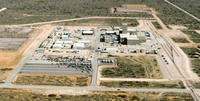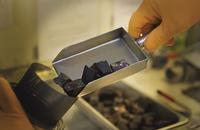-
Mustard plants help detect use of chemical weapons
Making nations comply with the Chemical Weapons Convention requires that scientists can accurately detect the use of chemical warfare agents. Currently they carry out tests on soil from areas where use is suspected. Many nerve agents composed of organo-phosophorous compounds, however, leach from soil over time, removing the evidence of use and making verifying the deployment of chemical weapons like sarin, soman, and VX difficult. Researchers report that white mustard plants can help by allowing detection for up to forty-five days after the chemical weapons were used.
-
-
Snowden revelations spur a surge in encrypted e-mail services
The Edward Snowden revelations about National Security Agency(N.S.A) surveillance programs have fueled a surge of new e-mail encryption services. “A lot of people were upset with those revelations, and that coalesced into this effort,” said the co-developer of a new encrypted e-mail service which launched last Friday. The company notes that its servers are based in Switzerland, making it more difficult for U.S. law enforcement to reach them.
-
-
Hitting the reset button on Secure Communities
Last Tuesday law enforcement officials said they anticipate a “reboot” of the controversial immigration enforcement program, Secure Communities, in which police officers are asked to submit fingerprints taken by police to DHS so the individuals stopped by the police can be screened for deportation eligibility. Critics argue the program leads to too many low-level criminals and non-criminals being turned over to immigration authorities, and in addition to the cost involved in the process, the program could make witnesses and victims of crime reluctant to cooperate with law enforcement.
-
-
Converting light to sound for better weapons detection, medical imaging
A device that essentially listens for light waves could help open up the last frontier of the electromagnetic spectrum — the terahertz range. So-called T-rays, which are light waves too long for human eyes to see, could help airport security guards find chemical and other weapons. They might let doctors image body tissues with less damage to healthy areas. They could also give astronomers new tools to study planets in other solar systems. Those are just a few possible applications.
-
-
New Mexico demands clarifications, reassurances on WIPP radiation leaks

New Mexico’s environment secretary Ryan Flynn has ordered the Department of Energy (DOE) to explain how it will protect public health and the environment while it investigates a radiation leak at the underground Waste Isolation Pilot Plant (WIPP). The plant has not been in compliance with various permit requirements since the February underground fire and radiation leak, which eventually led to a plant shutdown.
-
-
Problems continue to plague the Oxide Conversion Facility at Y-12

Oxide conversion is critical to recycling weapons-grade uranium, making it useful in nuclear warheads or for other purposes. The Oxide Conversion Facility (OCF) at the Y-12National Security Complex has been operating inconsistently in recent years. A report by the staff of the Defense Nuclear Facilities Safety Board(DNFSB) said there was a plan to resume operations the week of 7 April 2014, but that did not happen.
-
-
New technology tests ammo while saving joints
Firing and testing thousands of rounds of ammunition weekly can challenge the human body — even ones in top physical condition — causing debilitating stress injuries and chronic nerve and joint pain. DHS Science and Technology Directorate (S&T), with the help of agents from ICE Office of Firearms and Tactical Programs (OFTP) Armory Operations Branch (AOB), has taken an important step forward in reducing or eliminating these injuries by developing of the “Virtual Shooter.”
-
-
UN mulling rules to govern autonomous killer robots
On Tuesday, delegates from several international organizations and governments around the world began the first of many round of talks dealing with some call “lethal autonomous weapons systems” (LAWS), and others call “killer robots.” Supporters of LAWS say the technology offers life-saving potential in warfare, as these robots y are able to get closer than troops to assess threats without letting emotions interfere in their decisions. This is precisely what concerns critics of the technology. “If we don’t inject a moral and ethical discussion into this, we won’t control warfare,” said one of them.
-
-
Texas cities adopt 911 texting

Adding to the rising number of U.S. cities that accept 911 emergency texts, North Texas public safety agencies will now institute the procedure at their response centers. 911 emergency texting not only helps the deaf, but it better caters to younger generations that do not recognize as much the divide between text and voice communications. The texting of additional media such as photos before the responders reach the site could also have a profound impact on the development of an emergency situation.
-
-
DOJ, NIST team up to shore up forensic science, but skeptics question effort
Five years ago, a report on the state of forensic science by the National Academy of Sciences decried the lack of sound science in the analysis of evidence in criminal cases across the country. It spurred a flurry of outrage and promises, but no immediate action. Now, renewed efforts are underway, with the Department of Justice (DOJ) and the National Institute of Standards & Technology (NIST) teaming up to create a National Commission on Forensic Science.
-
-
Colorado tries to increase safety of urban development in wildfire-prone areas
Colorado continues to deal with the challenge of building new urban developments while reducing wildfire risks. There are currently 556,000 houses built in burn zones around the state, and the demand for water to sustain residents and industries continue to rise. A new study predicts that development will occupy 2.1 million acres in wildfire-prone forests by 2030, an increase from one million acres today — just as wildfires continue to burn roughly 900,000 acres a year since 2000, compared with just 200,000 acres a year in the 1990s.
-
-
Pandemics: who should be given life-saving treatment first? Who should make the decision?
In the event of a flu pandemic, who should have priority access to life-saving ventilators, and who should make that determination? Few disaster preparedness plans have taken community values regarding allocation into account, but a new study is aiming to change that through public engagement with Maryland residents. “In the event of a healthcare crisis, understanding the community perspective and having citizen buy-in will be critical to avoid compounding the initial disaster with further social upheaval,” says the principal investigator.
-
-
Improving gloves to enhance first responders’ safety
Firefighters wear protective gloves called “structure gloves” to keep their hands safe on the job. The structure gloves currently used by firefighters, however, are not designed for the precision movements first responders must perform. There are many different types of structure gloves available, but none fully satisfies modern firefighters’ needs. Today’s compact tools often have small buttons that require nimble movements. Bulky gloves can make it difficult for firefighters to complete simple tasks without removing their gloves and compromising their safety. As advanced textile technology and materials continue to develop, the science behind firefighter structure gloves has adapted.
-
-
Fire experiments will test new firefighting tactics
Fire researchers at the National Institute of Standards and Technology (NIST) will return to Spartanburg, South Carolina, on 15-21 May 2014, as part of a collaborative effort on a series of controlled-burn experiments in detached single-family homes slated for demolition. Measurements of temperature, total heat flux and other ground truth data gathered during the live fire experiments will help the NIST team and its partners to further assess the effectiveness of new fire-suppression tactics known as transitional fire attack.
-
-
Sandia completes overhaul of key nuclear weapons test facilities
Sandia National Laboratories recently completed the renovation of five large-scale test facilities that are crucial to ensuring the safety and reliability of the U.S. nuclear weapons systems. The work supports Sandia’s ongoing nuclear stockpile modernization work on the B61-12 and W88 Alt, assessments of current stockpile systems and test and analysis for broad national security customers.
-
More headlines
The long view
Tantalizing Method to Study Cyberdeterrence
Tantalus is unlike most war games because it is experimental instead of experiential — the immersive game differs by overlapping scientific rigor and quantitative assessment methods with the experimental sciences, and experimental war gaming provides insightful data for real-world cyberattacks.
Using Drone Swarms to Fight Forest Fires
Forest fires are becoming increasingly catastrophic across the world, accelerated by climate change. Researchers are using multiple swarms of drones to tackle natural disasters like forest fires.
Testing Cutting-Edge Counter-Drone Technology
Drones have many positive applications, bad actors can use them for nefarious purposes. Two recent field demonstrations brought government, academia, and industry together to evaluate innovative counter-unmanned aircraft systems.
European Arms Imports Nearly Double, U.S. and French Exports Rise, and Russian Exports Fall Sharply
States in Europe almost doubled their imports of major arms (+94 per cent) between 2014–18 and 2019–23. The United States increased its arms exports by 17 per cent between 2014–18 and 2019–23, while Russia’s arms exports halved. Russia was for the first time the third largest arms exporter, falling just behind France.
How Climate Change Will Affect Conflict and U.S. Military Operations
“People talk about climate change as a threat multiplier,” said Karen Sudkamp, an associate director of the Infrastructure, Immigration, and Security Operations Program within the RAND Homeland Security Research Division. “But at what point do we need to start talking about the threat multiplier actually becoming a significant threat all its own?”
The Tech Apocalypse Panic is Driven by AI Boosters, Military Tacticians, and Movies
From popular films like a War Games or The Terminator to a U.S. State Department-commissioned report on the security risk of weaponized AI, there has been a tremendous amount of hand wringing and nervousness about how so-called artificial intelligence might end up destroying the world. There is one easy way to avoid a lot of this and prevent a self-inflicted doomsday: don’t give computers the capability to launch devastating weapons.
